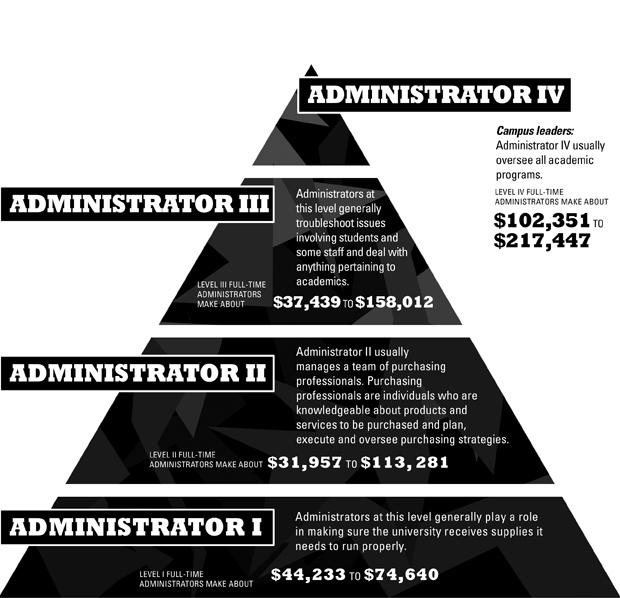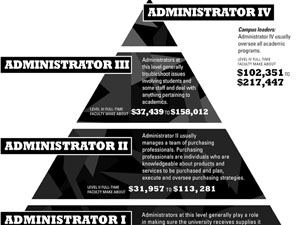CLARIFICATION: The below article and chart refer to administrators as “faculty.” Faculty members are those who teach, and while some administrators are also faculty members, not all administrators have held both positions. Administrators are also known as Management Personnel Plan (MPP) administrators.

As part of the Daily Sundial’s “Investigation Into Education” series, the jobs of administrators were broken down to levels of rank, income levels and job duties.
Though often unseen, administrators serve the CSUN community on a daily basis
Administrators are often misunderstood because many students might not be sure of exactly what they do because their work is not done in the classroom in the presence of students.
The reality is far from misconceptions as administrators have a heavy hand in everyday campus decisions.They have a broad and high impact on the university even though they are generally behind the scenes.
Lynn Marks, the compensation and classification manager of Human Resources, said there are 179 total CSUN Management Personnel Plan (MPP) administrators.
Marks said the university’s first priority is to promote the welfare and intellectual progress of students. Administrators impact the lives of students, staff, and faculty by developing and administering programs and activities in support of the university’s “mission, values, and vision.”
“To fulfill this mission, administrators work with other faculty and staff to design programs and activities to help students develop the academic competencies, professional skills, critical and creative abilities, and ethical values of learned persons,” she said. “In general, a CSU MPP administrator has significant responsibility for formulating, directing, and administering policies and programs.”
Although there are different levels of administrators, they all are responsible for day-to-day campus functions, managing budgets, personnel and policy, and representing and acting on behalf of the university in significant matters related to policies and programs.
Shira Brown, director of the Women’s Resource Center and gender and women’s studies professor, said she thinks administrators are frequently misunderstood and she believes all they want is for students to receive a quality education.
“A university is an organization and every organization needs different layers of support,” she said. “Faculty are soldiers on the frontline, but don’t deal with million dollar budgets or how many students can fit in a building like administrators do.”
“It is not easy work and they deal with problems of both faculty and students,” she added.
Professors interact with students directly on a daily basis while administrators generally interact with students indirectly.
There are different types of administrators on CSUN’s campus divided by administrator I, II, III and IV. These administrators each represent different levels of responsibility, authority and impact on the CSUN campus.
Administrator I
Administrators at this level generally play a role in making sure the university receives supplies it needs to run properly.
These full-time faculty make about $44,233 to $74,640 yearly.
Travis Thomas, materials manager for more than seven years and CSUN alumnus, said he handles central receiving, tracking capital and noncapital equipment on campus and manages the distribution system’s inventory of roughly $1 million to keep supplies going.
Thomas said his job affects students indirectly.
“I do not have a direct impact on students, but I make sure departments have what they need to work,” he said. “I am responsible for supplying materials custodians need to work to make sure campus is clean and well-maintained.”
Administrators have vast salary differences even within the same level due to various responsibilities.
“There are very wide salary ranges for the four different administrative levels to accommodate a wide variety of nature, scope, and complexity found in different MPP administrators,” Marks said.
“Also, these ranges are very broad to allow flexibility of use among all 23 CSU campuses, as well as the office of the chancellor, across the state,” he added
Thomas said he honestly thinks he is underpaid for the responsibilities and duties he performs.
“I don’t think a lot of people realize how much overtime we put in,” he said. “I don’t think it matches what you can get on the outside for the same amount of work. The benefits are incredible, but the salary could be more.”
Thomas said the biggest complaint he has heard about administrators is that they are disconnected from the campus.
“Many don’t feel administrators know what it takes to run the university and that we just push papers around,” Thomas said.
Administrator II
Administrator II usually manage a team of purchasing professionals. Purchasing professionals are individuals who are knowledgeable about products and services to be purchased and plan, execute and oversee purchasing strategies.
Administrator II full-time faculty make about $31,957 to $113, 281 yearly.
Deborah Flugum, manager, purchasing and contract administration for about two years, said she recruits, hires, evaluates and trains department support personnel, and oversees the professional development for department personnel.
“I develop and implement purchasing and contracting policies for the university,” Flugum said.
She added that she also handles any compliance issues for CSU policies of purchasing and contracts regarding administration, small business, Disabled Veteran Business Enterprise and recycling programs.
Flugum said her job affects students indirectly.
“We procure directly for the colleges and other administrative offices based on approved requests,” she said. “If we can’t procure the goods and services, the students cannot experience a higher education.
Flugum said she is satisfied with her earnings.
“After factoring in the benefits of working at this university, the total compensation towers over that in the private sector,” she said.
Administrator III
Administrators at this level generally troubleshoot issues involving students and some staff and deal with anything pertaining to academics.
Administrator III full-time faculty make about $37,439 to $158,012 yearly.
Christopher Jones, interim associate dean of the College of Business and Economics for about two months and CSUN alumnus, said some of his responsibilities are to have adequate physical resources for classrooms, direct curriculum, calling advising efforts in the college, accreditation, representing college at different meetings and being supportive of the dean by helping her vision and direction for the college.
“In the college of business and economics, the associate dean is responsible for day to day functions, makes sure instructors are present and there are classes to offer students,” Jones said. “I am involved with anything that deals with college and outreach and working with students is a major area.”
Administrators constantly hear complaints either from students, faculty or staff members such as the administrators are not as important as other positions on campus, are overpaid and underworked and are not needed at the university.
Jones said the greatest complaint he hears is that administrators are out of touch.
“Administrators do behind-the-scenes work and try to make things look seamless, and the process makes them look invisible on campus,” he said.
Jones said he was attracted to CSUN because it’s sophisticated, experienced and has a management team in place that knows how to run a university.
Cynthia Rawitch, who has worked at CSUN for 40 years and has been the vice provost for the last two, said she brings various parts of campus together for solutions, planning and organizing, and represent provost in committees and other duties as assigned.
Administrators’ jobs affect both CSUN students and faculty because they solve problems the university may be facing, are heavily involved in academic affairs and focused on student success.
Rawitch said she hopes her job affects students positively and that she deals with student retention and graduation rates.
“I come up with or recognize ideas of how to get students to university and move at a normal pace through courses,” she said. “My position is focused on student success and I managed to open more classes, clean up advisement and work indirectly from the office supporting faculty development.”
After multiple interviews with administrators, the majority of them said becoming an administrator was never their career goal.
Rawitch said she never intended on becoming an administrator and that she started as a journalism faculty member and that was all she wanted. The previous provost asked her to work with her on a project and Rawitch did. The project gave her a small view of the entire university which helped influence her to apply to become an administrator.
Administrator IV
Administrator IV usually oversee all academic programs.
Administrator IV full-time faculty make about $102,351 to $217,447 yearly.
Provost Harry Hellenbrand, administrator at CSUN for nine years, said he oversees faculty and staff and indirectly works with people who oversee curriculum.
Hellenbrand said CSUN is a great place to be because there are great teachers and students, and the highlight of being an administrator is meeting with people and talking to students and staff.
Although the day-to-day functions of CSUN administrators are demanding and could be very challenging, the administrators all said they would not want to work anywhere else or have any other position.
